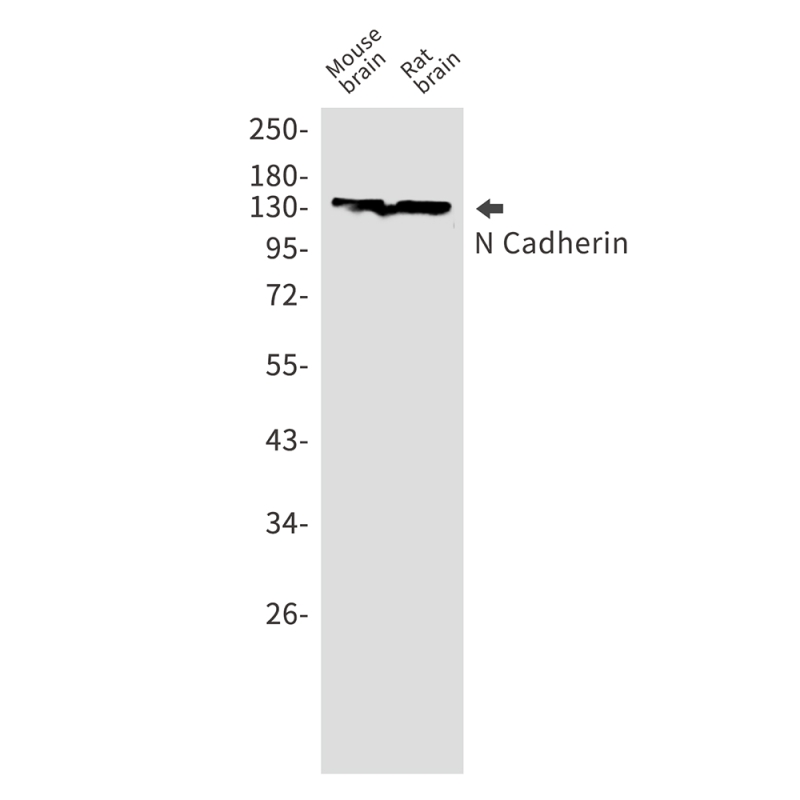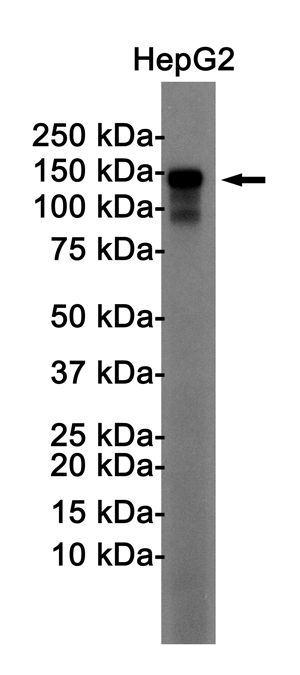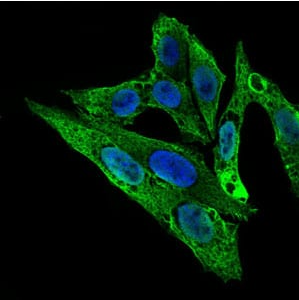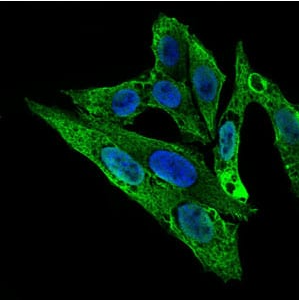


| WB | 1/500-1/1000 | Human,Mouse,Rat |
| IF | 1/20 | Human,Mouse,Rat |
| IHC | 咨询技术 | Human,Mouse,Rat |
| ICC | 技术咨询 | Human,Mouse,Rat |
| FCM | 咨询技术 | Human,Mouse,Rat |
| Elisa | 咨询技术 | Human,Mouse,Rat |
| Aliases | CDH2; CDHN; NCAD; Cadherin-2; CDw325; Neural cadherin; N-cadherin; CD antigen CD325 |
| Entrez GeneID | 1000 |
| WB Predicted band size | Calculated MW: 100 kDa; Observed MW: 140 kDa |
| Host/Isotype | Rabbit IgG |
| Antibody Type | Primary antibody |
| Storage | Store at 4°C short term. Aliquot and store at -20°C long term. Avoid freeze/thaw cycles. |
| Species Reactivity | Human,Mouse,Rat |
| Immunogen | Recombinant protein of human N Cadherin |
| Formulation | Purified antibody in TBS with 0.05% sodium azide,0.05%BSA and 50% glycerol. |
+ +
Western blot analysis of N Cadherin in mouse brain, rat brain lysates using N Cadherin antibody.
Western blot analysis of N Cadherin in HepG2 lysates using N Cadherin antibody.
以下是3篇关于N-Cadherin抗体的参考文献及其摘要概括:
---
1. **文献名称**: *"N-cadherin promotes adhesion between invasive breast cancer cells and the stromal microenvironment"*
**作者**: Hazan RB, et al.
**摘要**: 该研究利用N-Cadherin特异性抗体(如GC-4单克隆抗体),通过免疫荧光和功能阻断实验,证明N-Cadherin介导乳腺癌细胞与间质成纤维细胞的黏附,促进肿瘤侵袭和转移。
---
2. **文献名称**: *"Cadherins and EMT: a dual role in cancer progression"*
**作者**: Wheelock MJ, et al.
**摘要**: 综述分析了N-Cadherin抗体(如13A9克隆)在检测上皮-间质转化(EMT)中的应用,强调其在肿瘤细胞失去E-Cadherin后高表达,并通过体内外实验验证其促转移功能。
---
3. **文献名称**: *"Validation of N-Cadherin antibodies for reliable immunoblotting and immunohistochemistry"*
**作者**: Monica M, et al.
**摘要**: 比较了多种N-Cadherin抗体(如Clone 8C11、D4R1H)在Western blot和免疫组化中的特异性,发现部分抗体存在非特异性结合,推荐使用经敲除验证的高特异性抗体。
---
4. **文献名称**: *"N-Cadherin in the spotlight of signaling mechanisms in vascular biology"*
**作者**: Derycke LD, Bracke ME
**摘要**: 通过N-Cadherin抗体(如H-63多克隆抗体)研究其在血管内皮细胞黏附和血管生成中的作用,揭示其通过结合FGFR调控细胞迁移和信号传导的机制。
---
这些文献覆盖了抗体应用、功能机制及验证方法,可根据实验需求进一步筛选。建议结合具体研究领域(如癌症、发育生物学)选择针对性论文。
N-cadherin, a member of the classical cadherin family, is a calcium-dependent transmembrane glycoprotein that mediates cell-cell adhesion through homophilic interactions. Primarily expressed in neural tissues, mesenchymal cells, and developing organs, it plays critical roles in embryogenesis, tissue morphogenesis, and maintaining tissue architecture. Unlike E-cadherin, which is epithelial-specific, N-cadherin is associated with epithelial-mesenchymal transition (EMT), a process linked to cancer metastasis, wound healing, and stem cell differentiation. Its dysregulation is observed in various cancers, including breast, prostate, and glioblastoma, where elevated N-cadherin expression correlates with increased invasiveness and poor prognosis.
N-cadherin antibodies are essential tools for studying its localization, expression levels, and functional roles. These antibodies target specific extracellular or intracellular domains, enabling applications such as Western blotting, immunohistochemistry (IHC), immunofluorescence (IF), and flow cytometry. Validation parameters include specificity (confirmed via knockout models or siRNA silencing), cross-reactivity checks across species, and functional assays (e.g., adhesion blockade). Commercially available antibodies are typically raised in rabbits, mice, or goats, with monoclonal variants offering higher specificity. Researchers use these antibodies to explore N-cadherin’s involvement in signaling pathways (e.g., Wnt/β-catenin), neural circuit formation, and cardiovascular development. Challenges include distinguishing N-cadherin from other cadherins due to structural homology, emphasizing the need for rigorous validation in experimental models.
×
